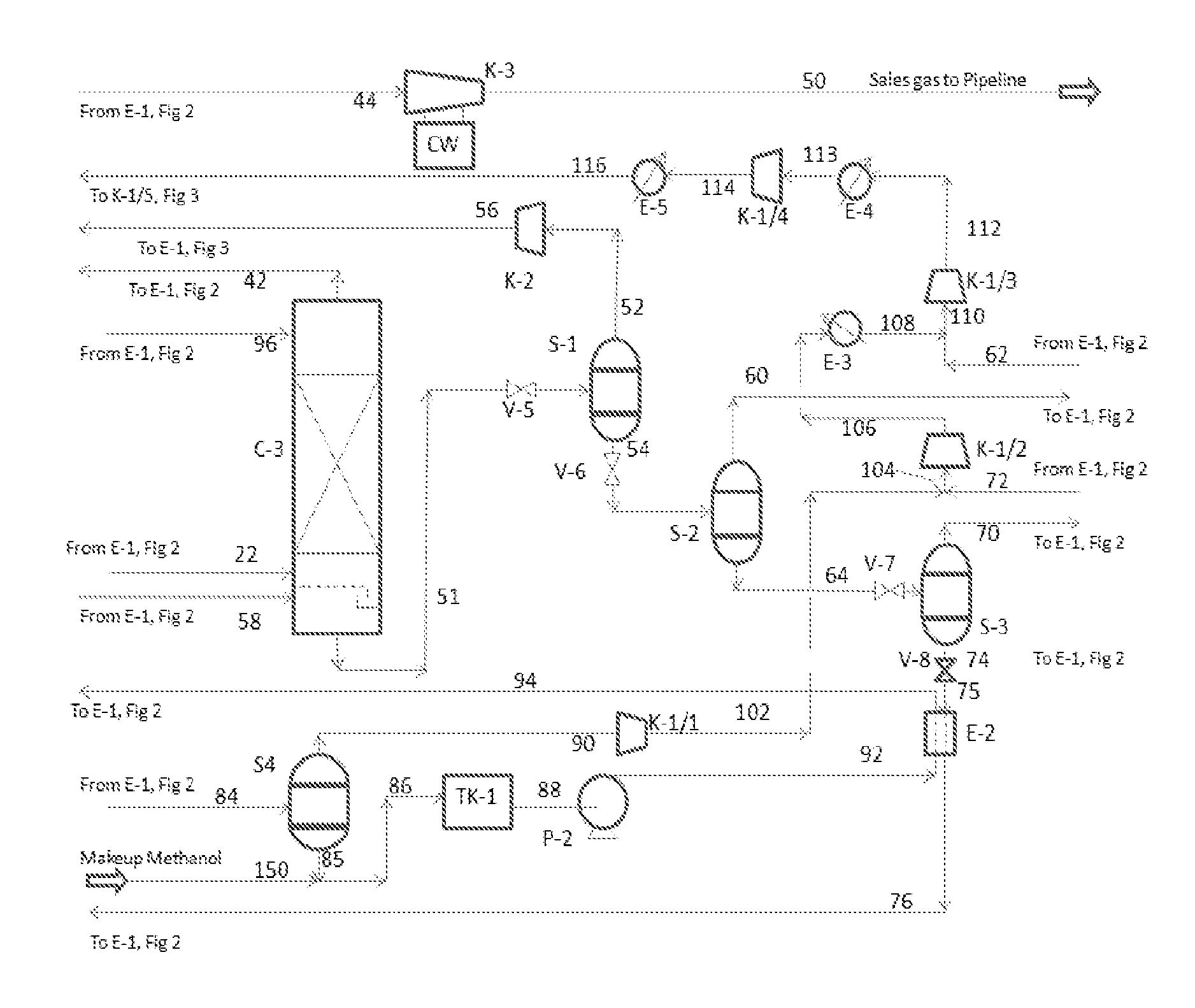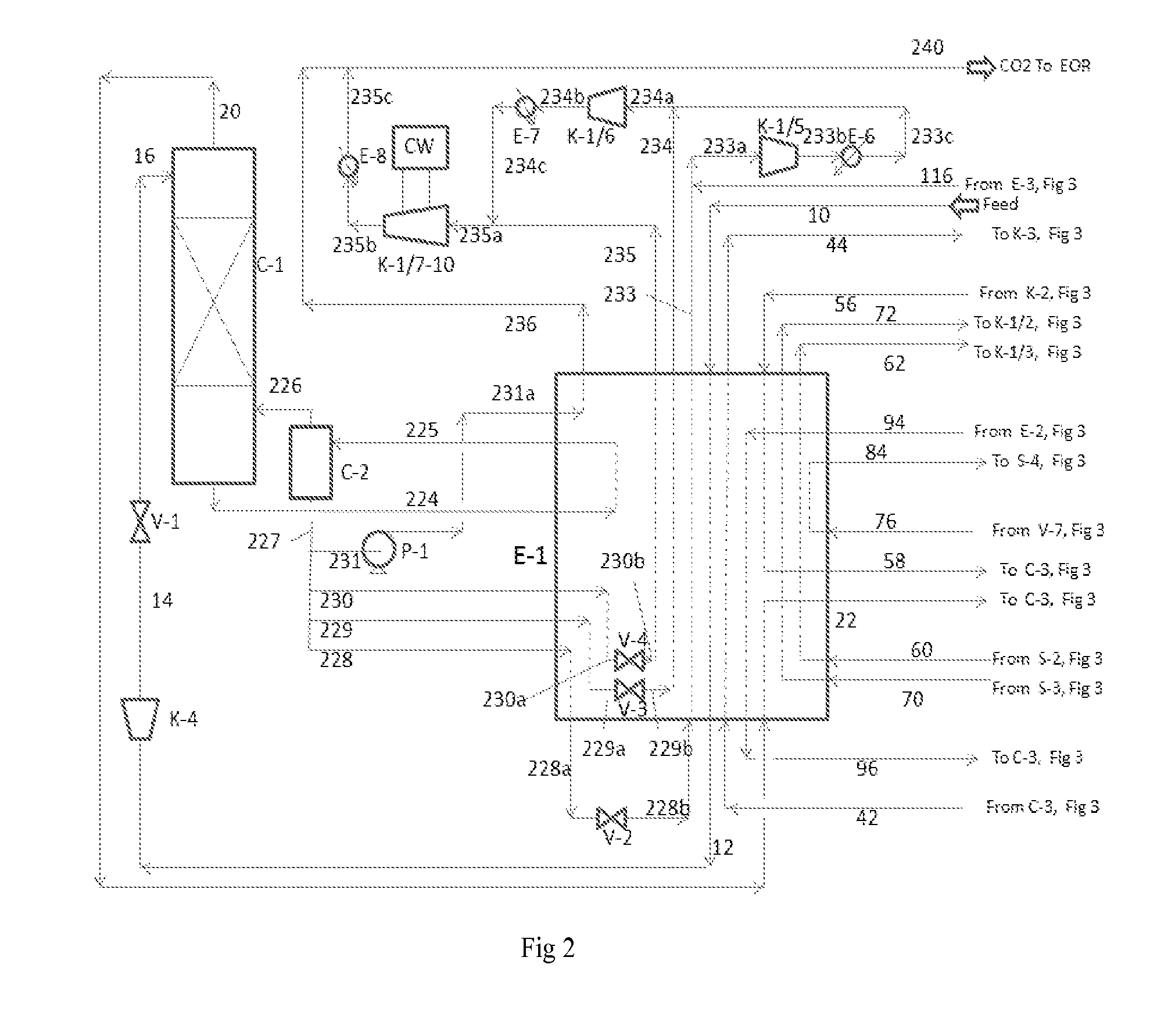Co2 capture from co2-rich natural gas
a technology of co2 and natural gas, applied in the field of co2 capture from co2rich natural gas, can solve the problem of reducing the compression duty of the system, and achieve the effect of reducing the capital cost of the compressor, great overall savings of capital and energy, and working very efficiently
- Summary
- Abstract
- Description
- Claims
- Application Information
AI Technical Summary
Benefits of technology
Problems solved by technology
Method used
Image
Examples
example-1
[0073]The Process Flow Diagram (PFD) is shown in FIG. 1. In the process, the feed gas mixture of CO2, methane, and small amounts of nitrogen and heavier hydrocarbons such as ethane, propane, butanes, pentanes, and hexanes at 800 psia and 100° F., in line 10, is first cooled and condensed in the combined reboiler and “second heat exchanger” (to be called Main Heat Exchanger), E-1. The condensed feed stream, in line 12, is let down in pressure to close to 483 psia by the Feed JT-valve, V-1, and fed to the top of the Prefractionator, C-1. The methane enriched overhead vapor, in line 20, from the top of Prefractionator C-1 is heated in the Main Heat Exchanger, E-1, and then taken out of E-1 at an intermediate location and sent for further CO2 removal in methanol absorption unit (to be called MAU, not shown).
[0074]The essentially CO2 and heavier hydrocarbons (0.1 mol % methane) bottoms liquid, to be called first stream, in line 24, of the Prefractionator, C-1, is split into four substrea...
example-2
[0081]This process is developed for CO2 capture from a natural gas containing 65 mol % CO2, similar to that in the example used by Ross and Cueller. The feed gas is at 1125 psia. The CO2 product is delivered at 1900 psia, and the (essentially methane) sales gas is delivered 1175 psia. Both are the same as those in Ross and Cueller's paper. Ross and Cueller claimed that using the Ortloff DRCF-SELEXOL hybrid process, they were able to reduce the power consumption from 81.9 MW needed for the conventional SELEXOL-only process to 45.5 MW and capital cost by $50 MM for a 400 MMSCFD feed gas flow plant.
[0082]Ross and Cueller did not specify the exact composition of the natural gas, but mentioned “65% CO2 and 35% hydrocarbon, predominately methane”. We assumed the feed contains 65 mol % CO2, 32 mol % methane, 1.46 mol % ethane, 0.41 mol % propane, 0.09 mol % isobutene, 0.16 mol % n-butane, 0.09 mol % isopentane, 0.05% n-pentane, 0.24 mol % n-hexane, and 0.5% nitrogen to mimic a “normal” gas...
PUM
| Property | Measurement | Unit |
|---|---|---|
| Temperature | aaaaa | aaaaa |
| Temperature | aaaaa | aaaaa |
| Pressure | aaaaa | aaaaa |
Abstract
Description
Claims
Application Information
 Login to View More
Login to View More - R&D
- Intellectual Property
- Life Sciences
- Materials
- Tech Scout
- Unparalleled Data Quality
- Higher Quality Content
- 60% Fewer Hallucinations
Browse by: Latest US Patents, China's latest patents, Technical Efficacy Thesaurus, Application Domain, Technology Topic, Popular Technical Reports.
© 2025 PatSnap. All rights reserved.Legal|Privacy policy|Modern Slavery Act Transparency Statement|Sitemap|About US| Contact US: help@patsnap.com



